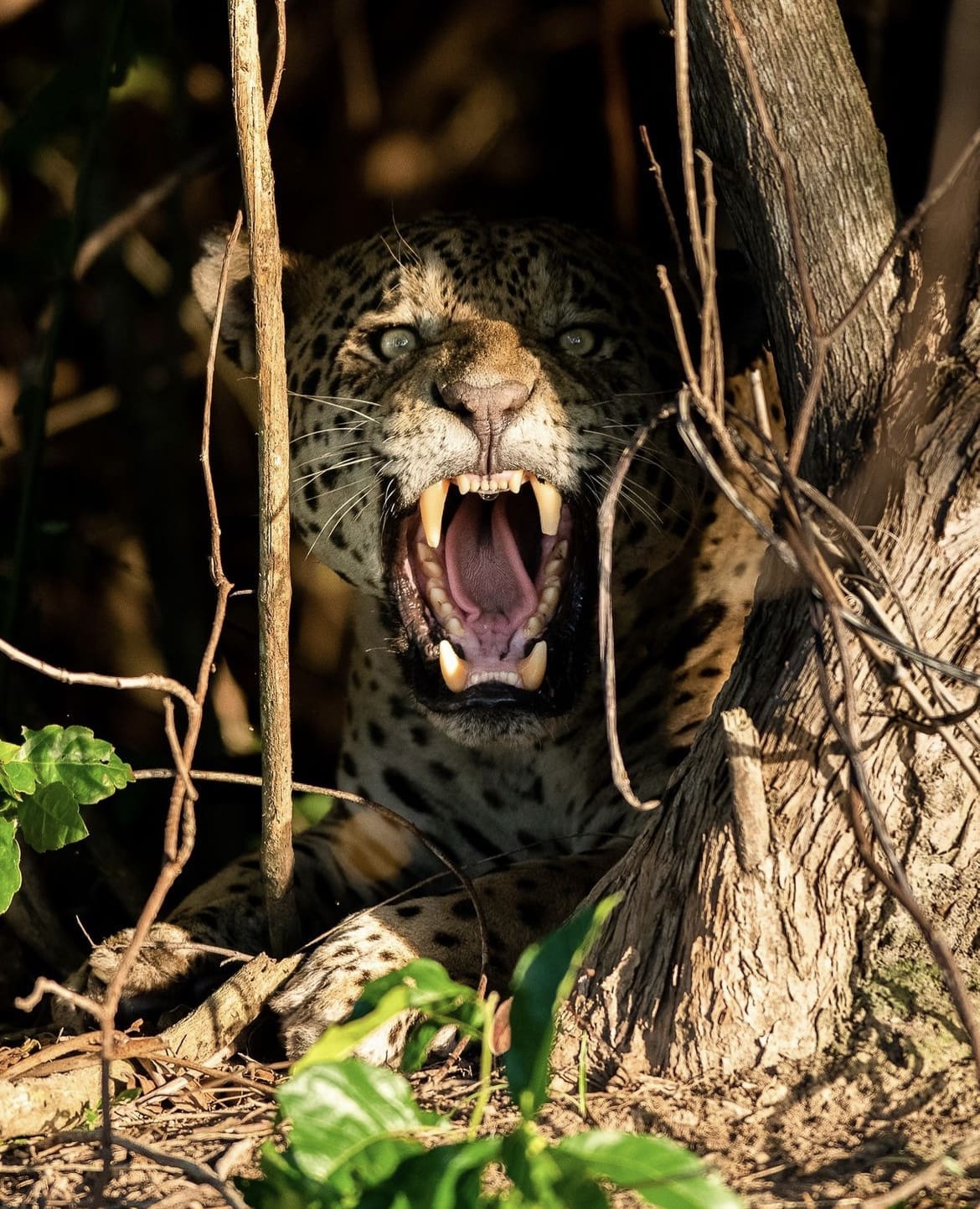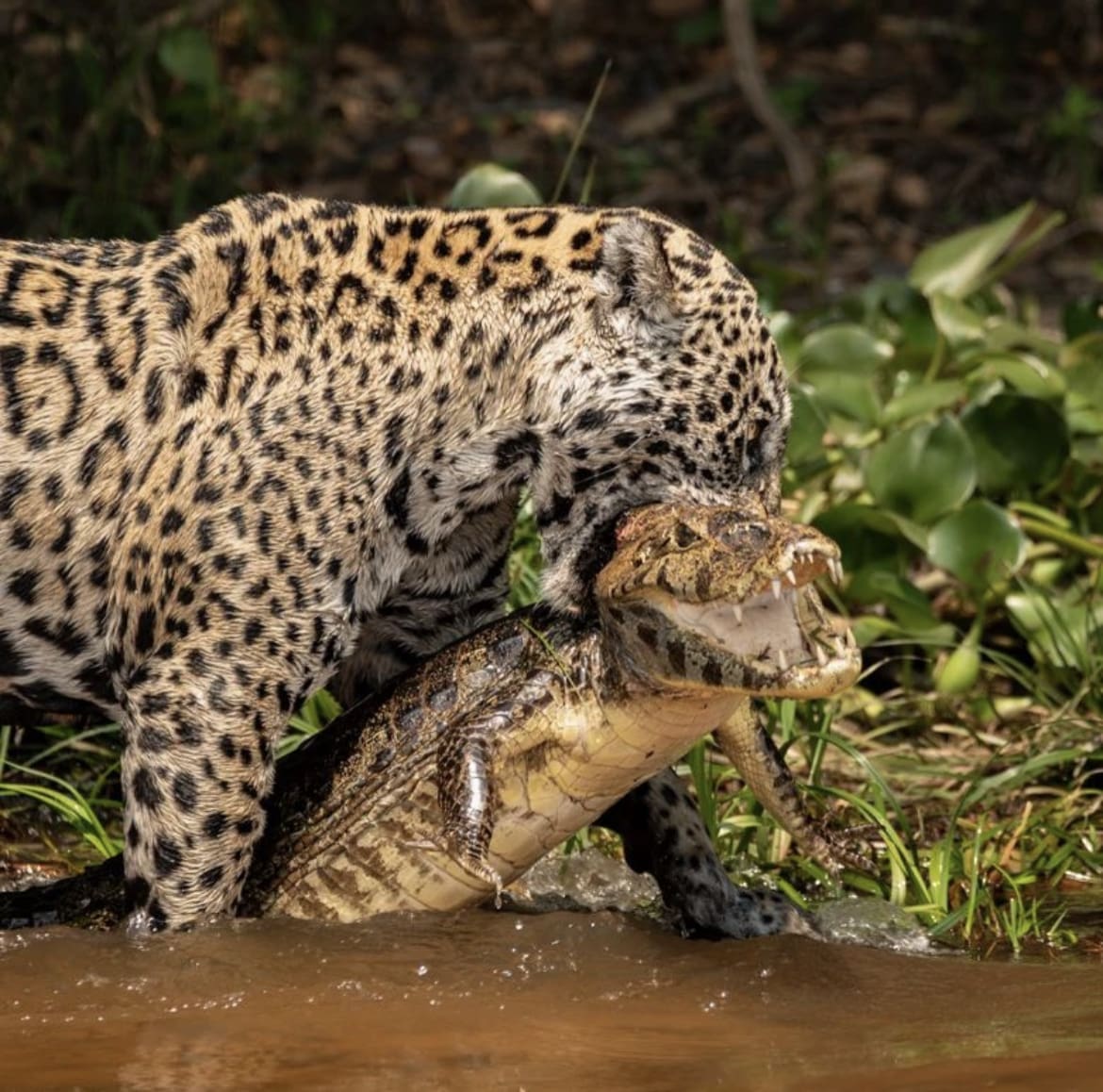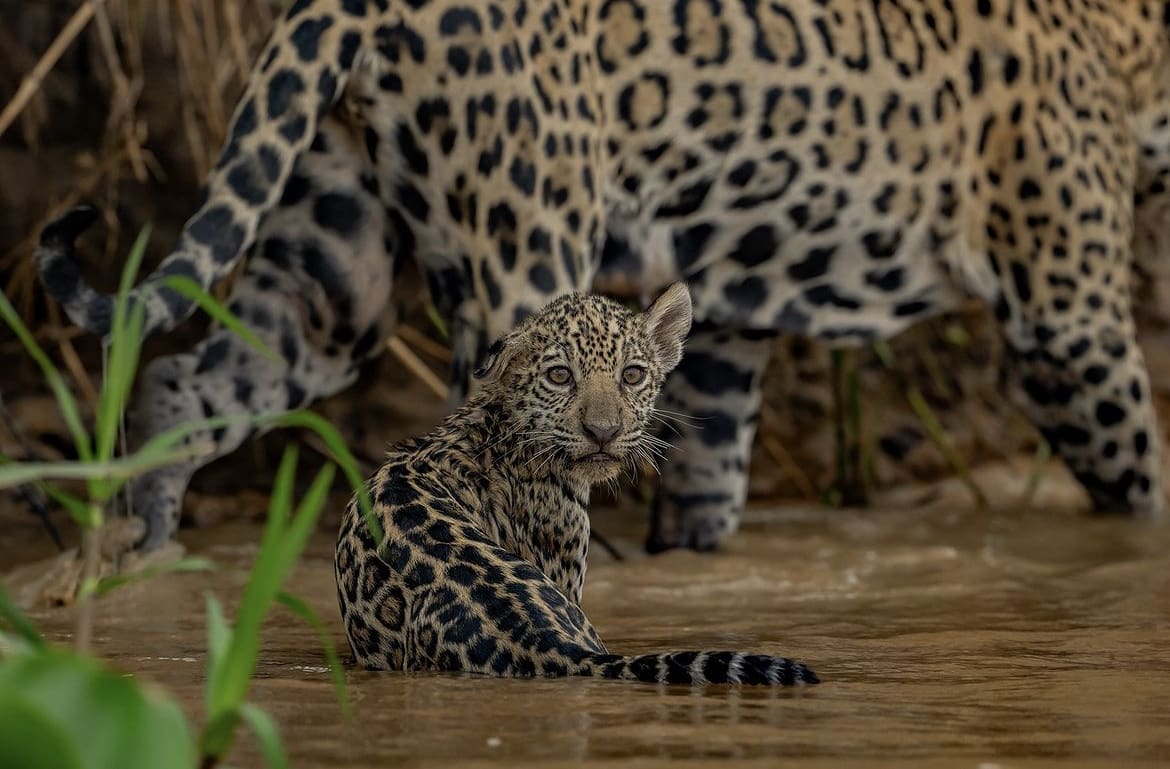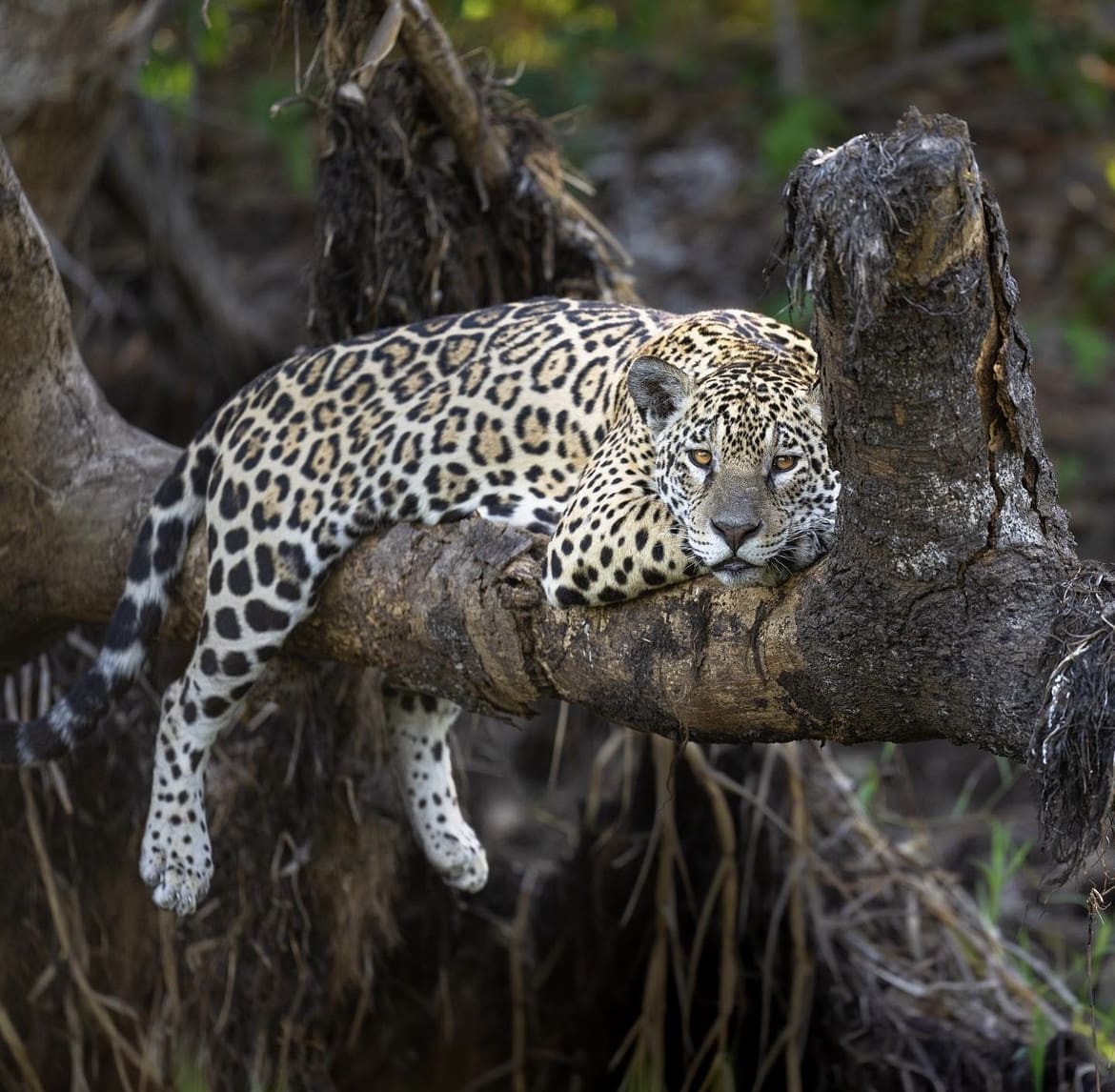One of the most enigmatic and jaw-dropping creatures that walk our planet is the jaguar.
Forget what you know from cartoons and logos; we’re about to get real about these big cats.
What is the Jaguar?
When you think of a jaguar, you might imagine a sleek, powerful animal lurking in the shadows of a dense jungle. And you wouldn’t be wrong. Jaguars are the third-largest big cats in the world, right after tigers and lions, and they reign supreme in the Americas. Scientifically known as Panthera onca, these animals are a symbol of might and mystique. They’re not just any predator; they’re apex predators, sitting at the top of the food chain, with no natural enemies except humans.
Jaguars are the embodiment of the wild’s untamed beauty, roaming the dense forests and open terrains of Central and South America. They play a crucial role in maintaining the balance of their ecosystems, controlling other populations and ensuring a healthy diversity. These cats are solitary creatures, preferring the quiet and peace of their own company, which makes them even more mysterious to us humans.
Jaguar vs Leopard
Alright, let’s clear up the confusion once and for all. Yes, jaguars and leopards look alike with their beautiful spotted coats, but they’re as different as, say, hipsters and surfers. First off, jaguars are bulkier, built like a linebacker with a compact body, a broad head, and powerful jaws. Leopards, on the other hand, are more like the marathon runner—lean and mean.
Their spots? Both have rosettes, but jaguars’ are larger and have spots inside them. Think of jaguar spots as being more complex and artsy. Location-wise, jaguars chill in the Americas, while leopards are globe-trotters, found in Africa and parts of Asia.
Behaviorally, jaguars love water and are excellent swimmers, often hunting in rivers and lakes. Leopards, though they can swim, prefer to keep their paws dry. So, next time you’re on a safari or a jungle expedition, remember: bulky and loves water? Jaguar. Lean and avoids water? Leopard.

What do Jaguars Look Like?
Imagine the most badass cat you can, and you’re pretty close to picturing a jaguar. These creatures boast an impressive physique. They’re muscular, with short, stocky limbs perfect for pouncing on prey or taking a leisurely swim. Jaguars have this captivating coat pattern with rosettes that are not just for show. These spots help them blend into the forest floor, making them nearly invisible to both prey and predator. It’s like nature’s own version of camouflage.
Their faces are something out of an ancient mask, with piercing eyes that seem to look right through you. Male jaguars are generally larger than females, but both share the same powerful build and distinctive coat. And those eyes… jaguars have this intense gaze that’s both beautiful and terrifying. It’s no wonder they’ve become a symbol of power and mystery in many cultures.
How Big are Jaguars?
When it comes to size, jaguars really bring their A-game. Males can weigh between 126 to 250 pounds (that’s like, a whole adult human and then some), while females are slightly smaller. They can grow up to 6 feet long, not including their tail, which adds another 2.5 feet. So, if you’re picturing a big cat, think of something that’s longer than your couch and way more muscular.
But here’s the kicker: despite their size, jaguars are masters of stealth. They move through the jungle with such grace and silence, you wouldn’t know one was nearby until it’s right on you. It’s this combination of power and stealth that makes the jaguar such a formidable predator.
Jaguar Skin
Jaguar skin is like the ultimate fashion statement in the animal kingdom. Each jaguar’s coat is unique, with rosettes that serve as both camouflage and a display of beauty. These rosettes are larger and more complex than those of their leopard cousins, with spots inside the rosettes. The skin beneath is thick and durable, protecting them from thorns and branches as they move through the dense jungle.
But it’s not just about looks. The jaguar’s skin is a critical adaptation for survival. The pattern of their coat mimics the play of light through dense foliage, breaking up their outline and making them nearly invisible to prey. It’s nature’s own invisibility cloak, and it’s absolutely brilliant.

Jaguar Claws
Now, let’s talk about one of the jaguar’s most fearsome weapons: its claws. These aren’t your average house cat’s scratchers. Jaguar claws are retractable, meaning they can be extended or withdrawn at will. This keeps them sharp for when they really need them, like catching dinner or climbing trees.
The claws themselves are long, sharp, and curved, designed to grab hold of prey and not let go. Whether it’s a caiman lounging by the river or a monkey swinging through the trees, once a jaguar’s claws are in, it’s game over. These claws are also used for marking territory, leaving deep scratches on trees as a sign to other jaguars to back off.
The power of a jaguar’s claw comes down to their incredible strength. They have one of the strongest bites of any big cat, capable of breaking through turtle shells and skull bones. Combine that with their lethal claws, and you’ve got a predator that’s at the top of its game.
Jaguar Colouration
Jaguars come in a palette that Mother Nature herself must have taken special time to concoct. Primarily, their coats shimmer in a golden hue, dappled with those distinctive rosettes perfect for blending into the sun-dappled underbrush. But, here’s where it gets really interesting—jaguars can also be melanistic. These are the so-called “black panthers,” cloaked in a sleek, dark coat with their rosettes barely visible in the right light. This stunning variation isn’t just for show; it provides an added layer of camouflage in the dense shadows of the jungle, proving nature’s flair for adaptability and style.
Whether golden or shadowed in darkness, a jaguar’s coloration is more than just skin deep. It’s a testament to their evolution, ensuring they remain unseen by prey until it’s too late. It’s their own version of stealth mode, and they wear it well, blending seamlessly into the canvas of their environments.
What do Jaguars Eat?
When it comes to dining, jaguars are not picky eaters. These apex predators have a diet as varied as the ecosystems they rule. At the top of their menu? Just about anything they can sink their teeth into. Jaguars are known to prey on more than 85 species, from fish and reptiles to birds and mammals. Capybaras, deer, tapirs, and even caimans are all fair game.
Jaguars have a unique hunting method—rather than chasing down their meals, they opt for a stealthy approach, using their camouflaged coats to sneak up on unsuspecting prey before delivering a fatal bite directly to the skull. It’s quick, efficient, and showcases the jaguar’s power and precision. They’re also one of the few cats that don’t shy away from water. In fact, they’re excellent swimmers and often hunt in rivers and wetlands, proving they’re as versatile as they are formidable.

Jaguar Social Structure
If jaguars were on social media, they’d be the ones with the private accounts. Solitary by nature, these cats prefer their own company, coming together only for the sake of mating. Each jaguar controls a vast territory, which they defend fiercely against intruders. These territories can overlap slightly with those of the opposite sex, but males especially don’t take kindly to other males stepping on their turf.
Communication among jaguars is a mix of scent marking, vocalizations, and scratch marks on trees. While they might not have a bustling social life, these methods ensure they keep in touch with their neighbors, setting boundaries, and signaling availability for mating. It’s like their own form of jungle messaging, ensuring everyone stays connected while keeping a respectful distance.
The solitary nature of the jaguar is not just a preference but a necessity, allowing them to control vast territories rich enough in resources to support their solitary lifestyle. This distance from one another underscores the importance of their territorial marks and the role they play in the survival of the species.
How do Jaguars Reproduce?
Jaguar love life is as stealthy and mysterious as their hunting strategy. These solitary animals only seek out company when it’s time to mate. During the mating season, females signal their readiness through scent marking and vocalizations, which can carry through the dense forest to reach potential mates. Once they find each other, jaguars will stay together for a brief period, a few days of romance involving mating and occasionally sharing meals.
After conception, the female embarks on a solitary journey of motherhood, with a gestation period lasting around 93 to 105 days. She’ll give birth to a litter of usually two to four cubs, hidden away in a secluded den. These cubs are born blind and utterly dependent on their mother, who fiercely protects and nurtures them until they’re ready to venture out into the world on their own, around two years of age. This period is crucial for the cubs to learn the essential skills for survival, from hunting to understanding their territory.
How Long do Jaguars Live?
In the wild, jaguars live lives full of challenges, from finding food to defending their territory. Despite these hardships, they can live up to 12 to 15 years, a testament to their resilience and adaptability. In captivity, where threats are minimal, and healthcare is available, jaguars have been known to live up to 20 years or more.
This significant difference underscores the impact of environmental pressures on their lifespan and the importance of conservation efforts to ensure they live fuller, safer lives in the wild.

Are Jaguars Aggressive?
Jaguars have a reputation that precedes them: powerful, fearless, and top of the food chain. But does this make them aggressive? Not necessarily. These big cats are naturally wary of humans and prefer to avoid us. Most of their aggression is reserved for hunting or defending their territory from other jaguars.
However, like any wild animal, jaguars will defend themselves if they feel threatened or cornered. Their powerful build and killer instincts make them formidable opponents, so it’s wise to respect their space and the wild environments they inhabit. Human-jaguar conflicts are rare and usually occur when their habitats overlap with human activities, leading to a decrease in their natural prey.
Understanding jaguar behavior, especially their tendencies toward aggression, is essential in fostering coexistence between humans and these magnificent creatures. Their aggressive nature is primarily geared towards survival and maintaining their status as apex predators, not towards unnecessary conflict.
Are Jaguars Territorial?
Absolutely, jaguars are the textbook definition of territorial animals. These majestic creatures demand and control vast areas of land for hunting and breeding. A male jaguar’s territory can span anywhere from 25 to over 50 square miles, depending on the availability of prey and the presence of females. Females also maintain their territories, although typically smaller than those of males. These territories often overlap with multiple females’ ranges, but males are not keen on sharing their space with other males.
Jaguars mark their territories with urine, feces, and by scratching trees, sending a clear message to any wandering jaguar to think twice before stepping in. This territorial nature ensures that jaguars have enough resources to survive and reproduce, crucial for their solitary lifestyle. It also reduces conflicts, as the boundaries are well established and generally respected among the jaguar population.
Do Jaguars Eat People?
The question of whether jaguars eat people taps into our primal fears of being hunted. The truth is, incidents of jaguars attacking humans are exceptionally rare. Jaguars are opportunistic hunters and prefer prey like deer, peccaries, and capybaras. Human-jaguar encounters are most likely to occur when their natural habitats are encroached upon by human activities, leading to a reduction in their natural prey.
In the historical and cultural context, there have been reports of jaguars attacking humans, but these are incredibly uncommon and often a result of provocation, habitat loss, or desperation due to lack of food.
Conservation efforts aim to reduce these encounters by protecting jaguar habitats and maintaining their natural prey populations, fostering a harmonious coexistence between jaguars and humans.
@marlondutoit
Where do Jaguars Live?
Jaguars are the masters of adaptability when it comes to their living quarters. Their range extends from the dense rainforests of the Amazon to the dry scrublands and grasslands, even venturing into the wetlands of the Pantanal, one of their stronghold habitats. These cats prefer dense forest cover for camouflage but are also known to roam in open areas, provided there’s enough cover for hunting.
The versatility in habitat preference underscores the jaguar’s adaptability, allowing them to survive in various environments. However, they are most commonly associated with the rainforest, which offers abundant prey and water. Unfortunately, habitat destruction and fragmentation pose significant threats to jaguar populations, restricting their range and limiting their ability to roam freely.
How do Jaguars Hunt?
Jaguars are solitary hunters, relying on stealth and power rather than speed. Their hunting technique is a testament to their patience and precision. They stalk their prey with unparalleled focus, moving silently through the underbrush or along riverbanks, blending into the environment until they’re close enough to launch a surprise attack.
Unlike other big cats that go for the neck, jaguars have a unique killing method—they deliver a powerful bite directly to the skull or neck of their prey, piercing through with their strong canines to cause instant death. This method is efficient and allows them to take down larger prey, such as caimans and tapirs, demonstrating their incredible bite force, the strongest of any big cat relative to their size.
Jaguars are also known to hunt in the water, showcasing their versatility as predators. They’re excellent swimmers and often catch fish, turtles, and even caimans by diving into rivers and lakes. This adaptability in hunting strategies underscores the jaguar’s role as a keystone species, maintaining the balance of their ecosystems by controlling other population numbers.

How Many Jaguars are There in the Wild?
Estimating the exact number of jaguars in the wild is challenging due to their secretive nature and vast, often inaccessible habitats. However, current studies suggest that the jaguar population is declining, with an estimated 15,000 to 50,000 individuals left in the wild. This wide range reflects the difficulties in tracking these elusive creatures across their range, from northern Mexico through Central America to South America’s southern tip.
Habitat loss and fragmentation are the main threats to jaguar populations, along with poaching and conflict with humans. The fragmentation of their habitats isolates populations, making it harder for jaguars to find mates and decreasing genetic diversity, which is crucial for the species’ resilience and survival.
Are Jaguars Endangered?
The jaguar is currently classified as Near Threatened on the IUCN Red List of Threatened Species, with some subpopulations being considered endangered. This status reflects the significant challenges jaguars face, including habitat destruction due to deforestation, agricultural expansion, and urban development. Illegal poaching for their fur, bones, and other body parts, along with retaliatory killings by farmers protecting livestock, further exacerbate their decline.
Conservation efforts are in place across the jaguar’s range, focusing on protecting habitats, creating wildlife corridors to connect isolated populations, and working with local communities to mitigate human-jaguar conflicts. These efforts are crucial for the survival of the species, aiming to stabilize and eventually increase jaguar populations in the wild.
Threats to Jaguars in the Wild
The jaguar’s existence is increasingly threatened by a combination of human activities. Deforestation for agriculture and urban development erodes their natural habitats, leaving jaguars with shrinking spaces to hunt and live. This habitat destruction is the primary threat, leading to decreased prey availability and increased conflict with humans as jaguars venture closer to farms and livestock in search of food.
Poaching remains a significant concern, with jaguars killed for their beautiful pelts, parts used in traditional medicine, and as trophies. Additionally, climate change poses a long-term threat, altering the ecosystems jaguars depend on for survival. Addressing these threats requires a concerted effort from conservationists, governments, and local communities to implement effective strategies that protect jaguar habitats and ensure their survival.

Where to See Jaguars
For those wishing to see these elusive cats in the wild, your best bets are the national parks and conservation areas across Latin America. The Pantanal, the world’s largest tropical wetland area spread across Brazil, Bolivia, and Paraguay, offers one of the highest probabilities of spotting jaguars in their natural habitat. Other notable spots include Belize’s Cockscomb Basin Wildlife Sanctuary, Costa Rica’s Corcovado National Park, and Mexico’s Calakmul Biosphere Reserve.
These areas, known for their rich biodiversity, provide opportunities to observe jaguars, especially near rivers during the dry season when jaguars come to drink and hunt. Eco-tours and guided safaris in these regions contribute to conservation efforts, offering a sustainable way to experience the majesty of the jaguar while supporting the local economy.
Tips for Spotting Jaguars
Spotting a jaguar in the wild is a rare and thrilling experience, but it requires patience, respect for nature, and a bit of luck. Here are some tips for hopeful wildlife watchers:
- Go with an experienced guide: Local guides know the best spots and times for sightings and can safely navigate jaguar habitats.
- Be patient and quiet: Jaguars are elusive and sensitive to noise. Patience and silence increase your chances of a sighting.
- Look near water sources: Jaguars often hunt and drink near rivers and lakes, especially in the early morning or late afternoon.
- Respect their space: Always maintain a safe distance. Encroaching on a jaguar’s territory can provoke them and disrupt their natural behavior.
- Support ethical tours: Choose eco-friendly tours that prioritize the welfare of wildlife and contribute to conservation efforts.

Facts about The Jaguar
- Jaguars have the strongest bite force of any big cat relative to their size.
- They are the only big cat in the Americas and the third largest in the world.
- Jaguars are skilled swimmers and often hunt in water.
- The name “jaguar” comes from the Indigenous Tupian word “yaguar,” meaning “he who kills with one leap.”
- Unlike other cats, jaguars often attack their prey by piercing the skull with their powerful bite.
Myths about The Jaguar
- Jaguars turn into black panthers at night: Melanistic (black) jaguars are a natural color variation, not a nocturnal transformation.
- Jaguars are aggressive towards humans: Jaguars generally avoid humans and are not naturally aggressive unless provoked or threatened.
- Jaguars roar like lions: While jaguars do make a range of vocalizations, their “roar” is more of a deep, coughing grunt than the lion’s iconic roar.
